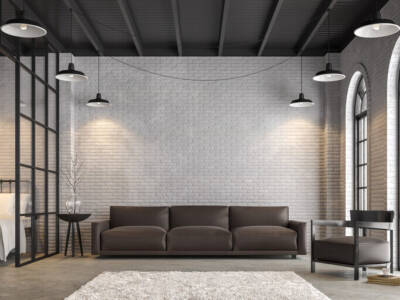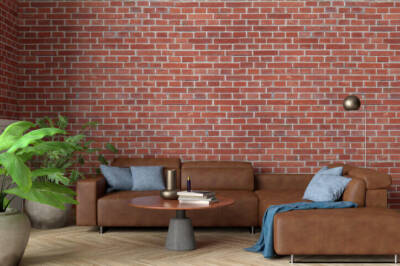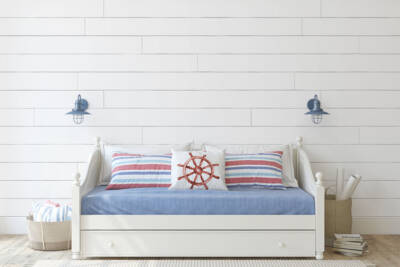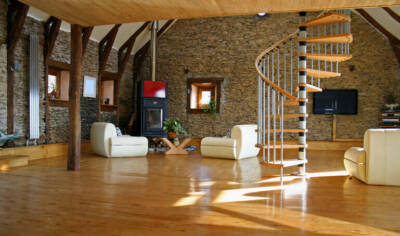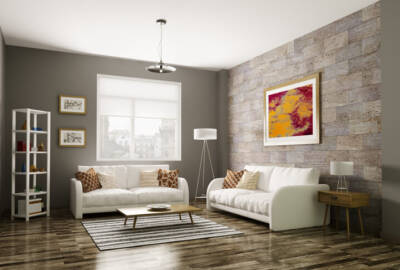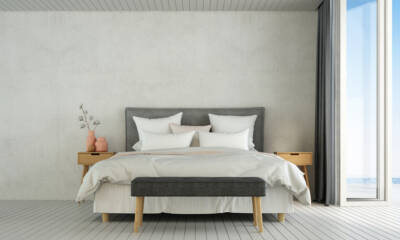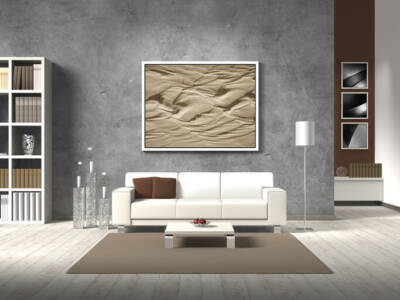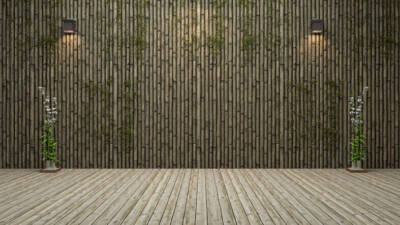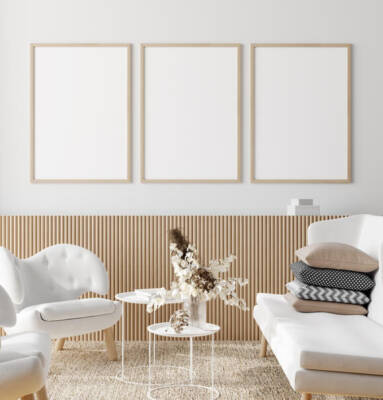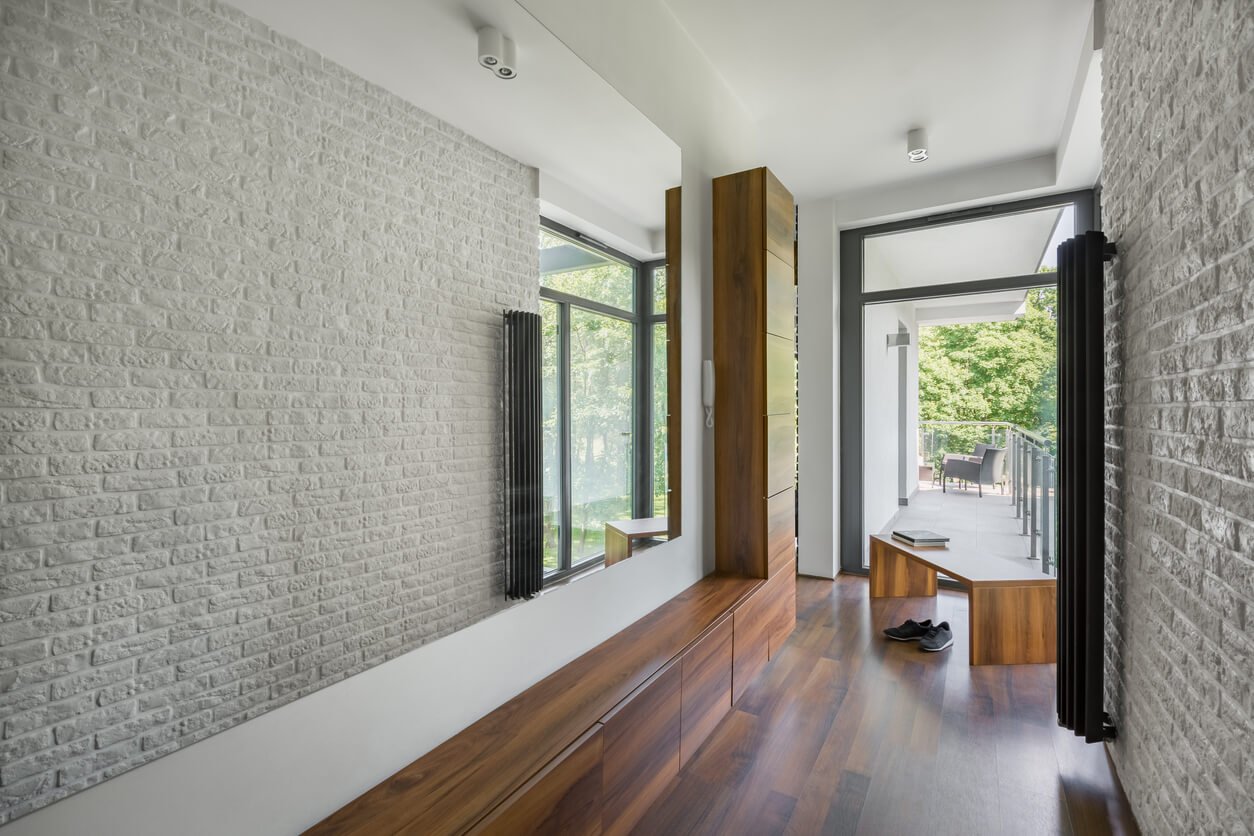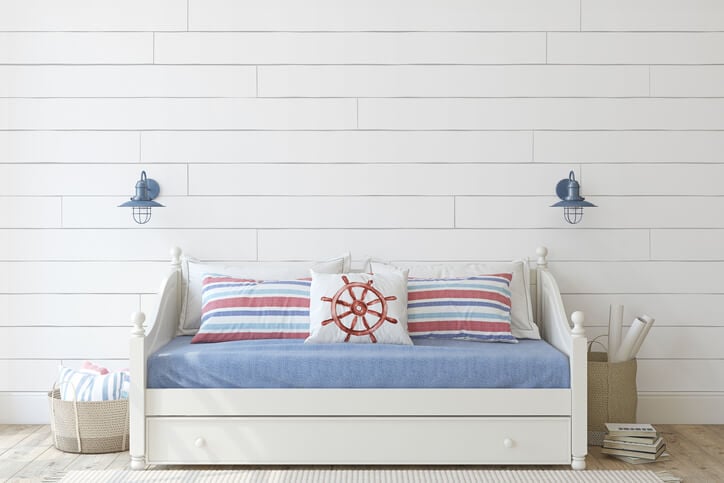
Adding an accent wall to a room is a creative and relatively simple way to add color and character to a space without needing to do a full redesign of the area. The asymmetry an accent wall provides is more than just stylish, it creates a specific style of your choice – modern, rustic, playful or natural – within a room and adds dimensions to fill space or draw attention.
But why just stay with color? Consider taking an accent wall to the next level by adding textures.
What Is a Textured Accent Wall?
A textured wall is any wall that has three dimensions, or at least the illusion of having three dimensions. Wallpaper or textured paint is one way to add a minimal amount of texture. For a bolder look, the use of certain building materials such as wood, brick or stone can add a greater dimension that allows you more control over the light and space within an area.
Accent walls that use real or faux building materials provide a striking contrast against other flat walls for an unmatched level of character. Whether for a house, apartment or business, the type and style of material you choose will depend largely on the space and what you want to do with it.
Types of Textured Accent Walls
Brick
No matter if you consider it industrial and historic or warm and elegant, few materials can match the look and feel of brick. Whether it’s a classic red brick, historic darker shades or a contemporary single color, brick’s unique texture is always an eye catcher.
Brick’s horizontal layers add a sense of flow and energy to a space, drawing eyelines across a wall to points of interest – such as a fireplace or bookshelf. A versatile material, brick is just as fitting within a rustic country house as it is within a modern city apartment.
Brick Accent Walls Examples
Wood
One of the most popular accent materials due to its many different looks, wood may be the most versatile building material you can use to accent a wall.
- Wood that looks weathered and aged provides a look that’s perfect for a rural or maritime aesthetic.
- Stained wood can provide either light and cheerful warmth or introduce a darker and refined atmosphere.
- Wood can also be painted over for a sleek and modern appearance, providing almost any color and style you can imagine.
Wood can be layered in vertical or horizontal lines, allowing for full control in how it moves within a space. Certain cuts and designs can also evoke specific classic styles:
- Shaker – these panels present a rustic, timeless look in a classic American style. This style can work well for outdoor or indoor use.
- Beadboard – a decorative paneling that combines a small town feeling with simple, yet elegant design. This is a great style for wainscoting.
Wood Accent Walls Examples
Stone
The ultimate expression of natural texture, stone is perfect for complementing other natural looks or for contrasting with more modern features and styles. The variance in color and texture of stacked stones make it an eye-pleasing accent that’s rich in character – no two stone walls will look alike.
Rounded fieldstones, carved stone blocks and stacked rough stone are just a few different styles you can choose from, with colors that range from cool creams and greys to warm tans and browns. Using specific types of stone can provide even more character:
- Cut stone – whether you’re going for Italian villa or styling after an English castle, cut stone can evoke a time and place of your desire.
- Riverstone – the rough and almost chaotic layout of riverstone brings the raw beauty of nature into your home.
Stone Accent Walls Examples
Metal and Concrete
Though a bit unconventional for use as materials on a finished wall, metal and concrete represent the ultimate in achieving a modern or industrial style.
Concrete is a stark and minimalist feature that creates a sense of open space. Concrete blocks can mimic the look of rock or stone. Rough or smooth wall panels create a solid design that’s cool and calm.
Metal walls achieve an entirely unique design that can make a wall into a conversation piece or bring life to a workplace. Diamond plate in particular is a look that can’t be achieved through other materials.
Metal and Concrete Accent Walls Examples
Bamboo
If you’re going for a tropical décor or an Asian aesthetic, then bamboo is a unique material that imparts a very particular style and character onto a wall. Indoor bars, outdoor pool areas, or perhaps a patio or veranda can be brought to life with a dramatic vibe.
Bamboo Accent Walls Examples
How To Determine What's Best for Your Needs?
With so many different options, what’s the best to choose? Even if you already have a design in mind, take the following tips under advisement:
- Consider the space and the look you’re going for
Different rooms have specific uses, and how you’re planning to use that room could determine which material fits better for an accent wall. A stone wall would fit for a natural and rustic bathroom designed for heavy use by children, whereas a dark wood accent wall would fit better in a clean and modern master bathroom.
If a bedroom is meant to be more of a sitting room, then light wood would keep it warm and inviting. If sleep and comfort is the most important thing, then a brick accent among dark walls would create a cozy and stylish bedroom. Remember that dark areas are easier to keep clean, so consider who’s using the room and for what purpose.
- Decide which wall is best served by an accent
You’ll want to use the accent wall to carve out a space within a room, as the asymmetry naturally draws attention. It’s a great choice for use in a room that does not have an architectural feature like fireplace or bookshelf. Alternatively, the wall could be used to balance or offset another feature, like being opposite a large picture window.
Accent walls are also great to use as a transition space within in a hallway or corridor. They can mark where people leave one area of a house to enter another, like moving from a more open and public space to a more private room. In any location, try to avoid placing the accent on walls that are already busy with paintings, windows or other decorations.
- Know your room colors and whether you want to complement or contrast
You can pair like with like for a subtle feel or go for an opposite approach for more dynamic energy.
- Bright accent walls used in light rooms are modern and stark
- Dark accent walls in dark rooms are cozier and more intimate
- Light accent walls brighten darker rooms and make them appear larger
- Dark accent walls draw attention in light rooms and provide more depth
- In a neutral room, how bold are you comfortable going?
Rooms that are primarily a soft beige are thought of as “neutral” – neither dark nor too light. If you’d prefer to keep things soft and tranquil, then adding a muted color or simple texture can provide the gentle touch such a room needs to move from simple to stylish.
If you’d rather add a bold and colorful accent wall with more texture, make sure that such a feature ties into other elements of the room. A dark wood wall could pair nicely with a new black leather couch. Bright red brick may complement a collection of colorful paintings.
- Don’t be afraid to mix and match materials
You don’t have to limit yourself to just one material. Combining materials onto one wall, or putting up two complementary accent walls, can really emphasize the style you’re trying to achieve.
- Darker materials with strong textures, like brick, style well with wood in natural stain or dark colors.
- Using both stone and wood for accent walls provides the pinnacle of a “deep woods” rustic look.
- A combination of concrete and brick can evoke a specialized industrial style for a workspace or garage.
- Don’t be limited to walls
Accents don’t have to be just for walls. Ceilings can be accented as well. Use darker materials to make the entire room feel cozier or lighter ones to make the ceiling appear higher. Bookshelves and fireplaces can also be enhanced with textures to make them stand out more.
- Consider what’s simple and cost effective
One of the most important considerations for designing an accent wall is the cost, availability and requirement for using certain materials. Every material has its own specific challenges:
- Stone is heavy and can be challenging to source, making it one of the most expensive materials to use. It also requires masonry to install, adding to the expense.
- Solid brick also requires masonry to install, and even brick veneer will need to be grouted. Some styles and colors of brick can be difficult to source.
- Although wood is plentiful, it can be difficult to source the specific types of wood or bamboo that you’d like to use for your wall.
- Concrete takes a lot of time and effort to set up, making a considerable mess in the process.
Opting instead to use faux paneling can solve many of the challenges with deciding which material to use. Faux wall panels are available in a variety of material looks, all with their own variations of styles and colors.
Installing Textured Wall Panels
If you are seeking the style and character of an accent wall but want something that’s significantly easier to install than most materials and will save you time and money, then choose your design from our selection of faux wall panels.
Our more than 850 designs achieve extraordinarily realistic recreations of wood, stone, brick and other materials. The textured accent walls of your choice are available in a variety of color and shades that are all lightweight and simple to install. Best of all, faux wall panels are less expensive than natural materials.
Take a look at our selection of styles, view our gallery, or contact one of our specialists for assistance.

